[English] 日本語
 Yorodumi
Yorodumi- PDB-4aen: HLA-DR1 with covalently linked CLIP106-120 in reversed orientation -
+ Open data
Open data
- Basic information
Basic information
| Entry | Database: PDB / ID: 4aen | ||||||
|---|---|---|---|---|---|---|---|
| Title | HLA-DR1 with covalently linked CLIP106-120 in reversed orientation | ||||||
 Components Components |
| ||||||
 Keywords Keywords | IMMUNE SYSTEM / SELF ANTIGEN / INVARIANT CHAIN / CLIP | ||||||
| Function / homology |  Function and homology information Function and homology informationnegative regulation of peptide secretion / macrophage migration inhibitory factor signaling pathway / NOS2-CD74 complex / MHC class II protein binding, via antigen binding groove / antigen processing and presentation of endogenous antigen / positive regulation of dendritic cell antigen processing and presentation / negative regulation of T cell differentiation / macrophage migration inhibitory factor binding / positive regulation of macrophage migration inhibitory factor signaling pathway / protein trimerization ...negative regulation of peptide secretion / macrophage migration inhibitory factor signaling pathway / NOS2-CD74 complex / MHC class II protein binding, via antigen binding groove / antigen processing and presentation of endogenous antigen / positive regulation of dendritic cell antigen processing and presentation / negative regulation of T cell differentiation / macrophage migration inhibitory factor binding / positive regulation of macrophage migration inhibitory factor signaling pathway / protein trimerization / macrophage migration inhibitory factor receptor complex / regulation of interleukin-4 production / positive regulation of cytokine-mediated signaling pathway / regulation of interleukin-10 production / myeloid dendritic cell antigen processing and presentation / antigen processing and presentation of endogenous peptide antigen via MHC class II / autolysosome membrane / regulation of T-helper cell differentiation / positive regulation of prostaglandin biosynthetic process / T cell activation involved in immune response / T cell selection / positive regulation of type 2 immune response / positive regulation of CD4-positive, CD25-positive, alpha-beta regulatory T cell differentiation / MHC class II receptor activity / host-mediated suppression of symbiont invasion / positive regulation of CD4-positive, alpha-beta T cell activation / MHC class II protein binding / negative thymic T cell selection / antigen processing and presentation of peptide or polysaccharide antigen via MHC class II / negative regulation of mature B cell apoptotic process / positive regulation of kinase activity / positive regulation of memory T cell differentiation / positive regulation of T cell mediated immune response to tumor cell / positive regulation of monocyte differentiation / positive thymic T cell selection / inflammatory response to antigenic stimulus / CD4 receptor binding / vacuole / cytokine receptor activity / positive regulation of chemokine (C-X-C motif) ligand 2 production / intermediate filament / prostaglandin biosynthetic process / positive regulation of neutrophil chemotaxis / T-helper 1 type immune response / positive regulation of T cell differentiation / positive regulation of macrophage cytokine production / negative regulation of intrinsic apoptotic signaling pathway in response to DNA damage by p53 class mediator / transport vesicle membrane / cytokine binding / antigen processing and presentation / regulation of macrophage activation / Translocation of ZAP-70 to Immunological synapse / Phosphorylation of CD3 and TCR zeta chains / nitric-oxide synthase binding / negative regulation of DNA damage response, signal transduction by p53 class mediator / polysaccharide binding / : / negative regulation of type II interferon production / immunoglobulin mediated immune response / humoral immune response / macrophage differentiation / Generation of second messenger molecules / immunological synapse / Co-inhibition by PD-1 / epidermis development / response to type II interferon / positive regulation of insulin secretion involved in cellular response to glucose stimulus / detection of bacterium / T cell receptor binding / positive regulation of chemokine production / negative regulation of T cell proliferation / positive regulation of B cell proliferation / multivesicular body / protein folding chaperone / MHC class II antigen presentation / lysosomal lumen / negative regulation of cell migration / trans-Golgi network membrane / Cell surface interactions at the vascular wall / positive regulation of interleukin-8 production / protein tetramerization / intracellular protein transport / peptide antigen assembly with MHC class II protein complex / lumenal side of endoplasmic reticulum membrane / negative regulation of inflammatory response to antigenic stimulus / MHC class II protein complex / clathrin-coated endocytic vesicle membrane / ER to Golgi transport vesicle membrane / antigen processing and presentation of exogenous peptide antigen via MHC class II / positive regulation of immune response / peptide antigen binding / positive regulation of T cell activation / structural constituent of cytoskeleton / positive regulation of T cell mediated cytotoxicity / positive regulation of interleukin-6 production / cognition / positive regulation of fibroblast proliferation / Interferon gamma signaling / positive regulation of protein phosphorylation / MHC class II protein complex binding Similarity search - Function | ||||||
| Biological species |  HOMO SAPIENS (human) HOMO SAPIENS (human) | ||||||
| Method |  X-RAY DIFFRACTION / X-RAY DIFFRACTION /  SYNCHROTRON / SYNCHROTRON /  MOLECULAR REPLACEMENT / Resolution: 2.2 Å MOLECULAR REPLACEMENT / Resolution: 2.2 Å | ||||||
 Authors Authors | Schlundt, A. / Guenther, S. / Sticht, J. / Wieczorek, M. / Roske, Y. / Heinemann, U. / Freund, C. | ||||||
 Citation Citation |  Journal: J.Mol.Biol. / Year: 2012 Journal: J.Mol.Biol. / Year: 2012Title: Peptide Linkage to the Alpha-Subunit of Mhcii Creates a Stably Inverted Antigen Presentation Complex. Authors: Schlundt, A. / Gunther, S. / Sticht, J. / Wieczorek, M. / Roske, Y. / Heinemann, U. / Freund, C. | ||||||
| History |
|
- Structure visualization
Structure visualization
| Structure viewer | Molecule:  Molmil Molmil Jmol/JSmol Jmol/JSmol |
|---|
- Downloads & links
Downloads & links
- Download
Download
| PDBx/mmCIF format |  4aen.cif.gz 4aen.cif.gz | 97 KB | Display |  PDBx/mmCIF format PDBx/mmCIF format |
|---|---|---|---|---|
| PDB format |  pdb4aen.ent.gz pdb4aen.ent.gz | 73 KB | Display |  PDB format PDB format |
| PDBx/mmJSON format |  4aen.json.gz 4aen.json.gz | Tree view |  PDBx/mmJSON format PDBx/mmJSON format | |
| Others |  Other downloads Other downloads |
-Validation report
| Summary document |  4aen_validation.pdf.gz 4aen_validation.pdf.gz | 457.6 KB | Display |  wwPDB validaton report wwPDB validaton report |
|---|---|---|---|---|
| Full document |  4aen_full_validation.pdf.gz 4aen_full_validation.pdf.gz | 459.7 KB | Display | |
| Data in XML |  4aen_validation.xml.gz 4aen_validation.xml.gz | 18 KB | Display | |
| Data in CIF |  4aen_validation.cif.gz 4aen_validation.cif.gz | 25.9 KB | Display | |
| Arichive directory |  https://data.pdbj.org/pub/pdb/validation_reports/ae/4aen https://data.pdbj.org/pub/pdb/validation_reports/ae/4aen ftp://data.pdbj.org/pub/pdb/validation_reports/ae/4aen ftp://data.pdbj.org/pub/pdb/validation_reports/ae/4aen | HTTPS FTP |
-Related structure data
| Related structure data |  4ah2C  3pdoS C: citing same article ( S: Starting model for refinement |
|---|---|
| Similar structure data |
- Links
Links
- Assembly
Assembly
| Deposited unit | 
| |||||||||
|---|---|---|---|---|---|---|---|---|---|---|
| 1 |
| |||||||||
| Unit cell |
| |||||||||
| Components on special symmetry positions |
|
- Components
Components
| #1: Protein | Mass: 23167.883 Da / Num. of mol.: 1 / Fragment: EXTRACELLULAR DOMAIN, RESIDUES 26-217 Source method: isolated from a genetically manipulated source Source: (gene. exp.)  HOMO SAPIENS (human) / Production host: HOMO SAPIENS (human) / Production host:  | ||||
|---|---|---|---|---|---|
| #2: Protein | Mass: 23087.791 Da / Num. of mol.: 1 / Fragment: EXTRACELLULAR DOMAIN, RESIDUES 30-227 Source method: isolated from a genetically manipulated source Source: (gene. exp.)  HOMO SAPIENS (human) / Production host: HOMO SAPIENS (human) / Production host:  | ||||
| #3: Protein/peptide | Mass: 1865.459 Da / Num. of mol.: 1 / Fragment: RESIDUES 106-120 Source method: isolated from a genetically manipulated source Source: (gene. exp.)  HOMO SAPIENS (human) / Production host: HOMO SAPIENS (human) / Production host:  | ||||
| #4: Chemical | | #5: Water | ChemComp-HOH / | Has protein modification | Y | |
-Experimental details
-Experiment
| Experiment | Method:  X-RAY DIFFRACTION / Number of used crystals: 1 X-RAY DIFFRACTION / Number of used crystals: 1 |
|---|
- Sample preparation
Sample preparation
| Crystal | Density Matthews: 2.75 Å3/Da / Density % sol: 55.3 % / Description: NONE |
|---|---|
| Crystal grow | Details: 2 M (NH4)2SO4, 0.1 M TRIS, PH 8.0 |
-Data collection
| Diffraction | Mean temperature: 100 K |
|---|---|
| Diffraction source | Source:  SYNCHROTRON / Site: SYNCHROTRON / Site:  BESSY BESSY  / Beamline: 14.1 / Wavelength: 0.91841 / Beamline: 14.1 / Wavelength: 0.91841 |
| Detector | Type: MARMOSAIC 225 mm CCD / Detector: CCD / Date: Feb 22, 2011 / Details: MIRRORS |
| Radiation | Monochromator: SI-111 CRYSTAL / Protocol: SINGLE WAVELENGTH / Monochromatic (M) / Laue (L): M / Scattering type: x-ray |
| Radiation wavelength | Wavelength: 0.91841 Å / Relative weight: 1 |
| Reflection | Resolution: 2.2→34.42 Å / Num. obs: 27008 / % possible obs: 99.9 % / Observed criterion σ(I): -3 / Redundancy: 4.5 % / Biso Wilson estimate: 30.6 Å2 / Rmerge(I) obs: 0.08 / Net I/σ(I): 15.8 |
| Reflection shell | Resolution: 2.2→2.26 Å / Redundancy: 4.5 % / Rmerge(I) obs: 0.56 / Mean I/σ(I) obs: 2.9 / % possible all: 100 |
- Processing
Processing
| Software |
| |||||||||||||||||||||||||||||||||||||||||||||||||||||||||||||||||||||||||||||
|---|---|---|---|---|---|---|---|---|---|---|---|---|---|---|---|---|---|---|---|---|---|---|---|---|---|---|---|---|---|---|---|---|---|---|---|---|---|---|---|---|---|---|---|---|---|---|---|---|---|---|---|---|---|---|---|---|---|---|---|---|---|---|---|---|---|---|---|---|---|---|---|---|---|---|---|---|---|---|
| Refinement | Method to determine structure:  MOLECULAR REPLACEMENT MOLECULAR REPLACEMENTStarting model: PDB ENTRY 3PDO Resolution: 2.2→34.414 Å / SU ML: 0.56 / σ(F): 1.99 / Phase error: 20.58 / Stereochemistry target values: ML Details: OWING TO DISORDER FOLLOWING RESIDUES ARE MISSING COMPLETELY A-14-A2, A181-A192, B0-B2, B106-B112, B191-B198, C105. OWING TO DISORDER FOLLOWING RESIDUES COULD ONLY BE MODELED TO THE CBETA- ...Details: OWING TO DISORDER FOLLOWING RESIDUES ARE MISSING COMPLETELY A-14-A2, A181-A192, B0-B2, B106-B112, B191-B198, C105. OWING TO DISORDER FOLLOWING RESIDUES COULD ONLY BE MODELED TO THE CBETA-ATOM A3, B105, B166, C120
| |||||||||||||||||||||||||||||||||||||||||||||||||||||||||||||||||||||||||||||
| Solvent computation | Shrinkage radii: 0.86 Å / VDW probe radii: 1.1 Å / Solvent model: FLAT BULK SOLVENT MODEL / Bsol: 32.502 Å2 / ksol: 0.369 e/Å3 | |||||||||||||||||||||||||||||||||||||||||||||||||||||||||||||||||||||||||||||
| Displacement parameters | Biso mean: 25.6 Å2
| |||||||||||||||||||||||||||||||||||||||||||||||||||||||||||||||||||||||||||||
| Refinement step | Cycle: LAST / Resolution: 2.2→34.414 Å
| |||||||||||||||||||||||||||||||||||||||||||||||||||||||||||||||||||||||||||||
| Refine LS restraints |
| |||||||||||||||||||||||||||||||||||||||||||||||||||||||||||||||||||||||||||||
| LS refinement shell |
|
 Movie
Movie Controller
Controller




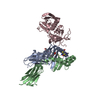
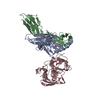

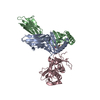
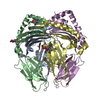

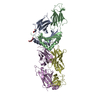
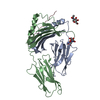



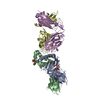









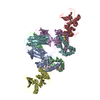

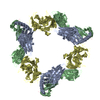




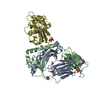
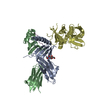



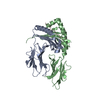

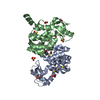

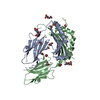
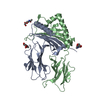
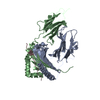

 PDBj
PDBj














